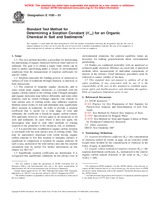Potrebujeme váš súhlas na využitie jednotlivých dát, aby sa vám okrem iného mohli ukazovať informácie týkajúce sa vašich záujmov. Súhlas udelíte kliknutím na tlačidlo „OK“.
ASTM E1195-01
Standard Test Method for Determining a Sorption Constant (Koc) for an Organic Chemical in Soil and Sediments
Automaticky preložený názov:
Štandardná skúšobná metóda pre stanovenie sorpčné konštanta ( KOC ) pre organickej chémie v pôde a sedimentoch
NORMA vydaná dňa 10.10.2001
Informácie o norme:
Označenie normy: ASTM E1195-01
Poznámka: NEPLATNÁ
Dátum vydania normy: 10.10.2001
Kód tovaru: NS-40827
Počet strán: 8
Približná hmotnosť: 24 g (0.05 libier)
Krajina: Americká technická norma
Kategória: Technické normy ASTM
Anotácia textu normy ASTM E1195-01 :
Keywords:
equilibrium sorption coefficients, partitioning of organic chemicals, sorption constant (Koc), ICS Number Code 13.080.10 (Chemical characteristics of soil)
Doplňujúce informácie
| 1. Scope | ||||||||||
|
1.1 This test method describes a procedure for determining the partitioning of organic chemicals between water and soil or sediment. The goal is to obtain a single value which can be used to predict partitioning under a variety of environmental conditions from the measurement of sorption coefficients for specific solids. 1.2 Sorption represents the binding process of chemicals to surfaces of soils or sediments through chemical, or physical, or both interactions. 1.3 The sorption of nonpolar organic chemicals, and to some extent polar organic chemicals, is correlated with the organic carbon content of the sorbing solid. Charged inorganic and organic molecules may behave differently, and some other property, such as, cation exchange capacity, clay content, or total surface area of sorbing solids, may influence sorption. Hydrous metal oxides of iron and aluminum may significantly affect sorption in sediments. In order to provide a sorption coefficient that is useful for a wide range of soils and sediments, the coefficient is based on organic carbon content. This approach, however, will not apply to all chemicals or all soils and sediments. In cases where it does not apply, the investigator may need to seek other methods of relating sorption to the properties of the chemical, soil, or sediment. 1.4 It is possible that, in addition to organic carbon, sorption is correlated with the total surface area of sorbing solids. This may be particularly important with solids having organic carbon contents so low that sorption to inorganic surfaces is significant in comparison to sorption by organic material. In such a case, inclusion of the total surface area into the sorption calculation may be useful. For further information on this subject see Ref (1). 1.5 Equilibrium sorption coefficients are determined. It is recognized that equilibrium conditions do not always exist in environmental situations, but sorption equilibria values are necessary for making generalizations about environmental partitioning. 1.6 Studies are conducted preferably with an analytical or technical-grade chemical. Mixtures are used only if analytical methods allow measurement of individual components of interest in the mixture. Good laboratory procedures must be followed to ensure validity of the data. 1.7 This standard does not purport to address all of the safety problems, if any, associated with its use. It is the responsibility of the user of this standard to establish appropriate safety and health practices and determine the applicability of regulatory limitations prior to use.</p> |
||||||||||
| 2. Referenced Documents | ||||||||||
|
Odporúčame:
Aktualizácia technických noriem
Chcete mať istotu, že používate len platné technické normy?
Ponúkame Vám riešenie, ktoré Vám zaistí mesačný prehľad o aktuálnosti noriem, ktoré používate.
Chcete vedieť viac informácií ? Pozrite sa na túto stránku.




 Cookies
Cookies
